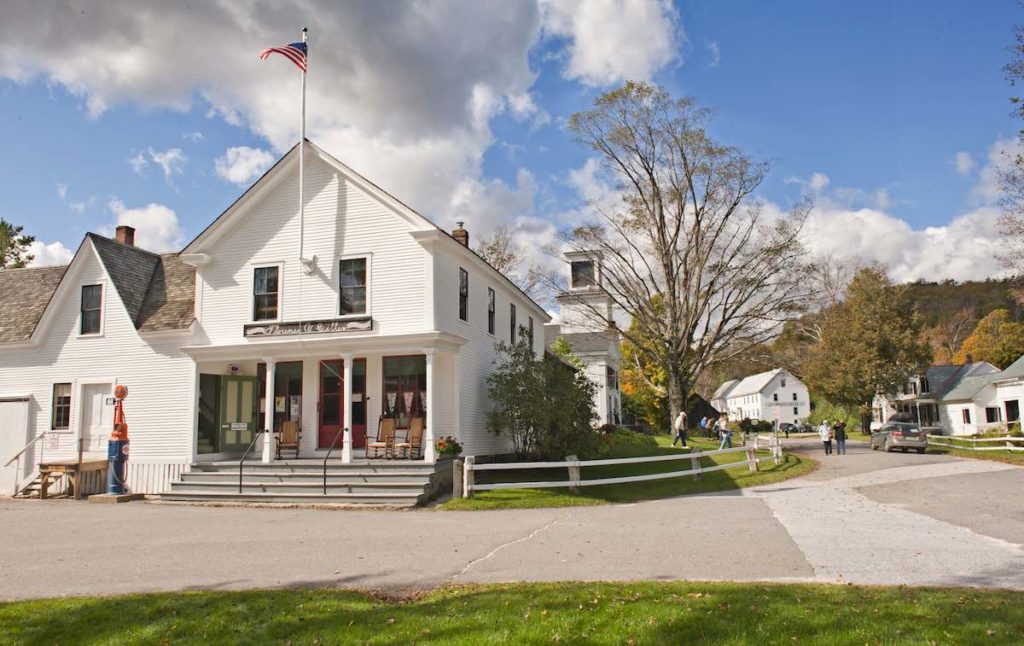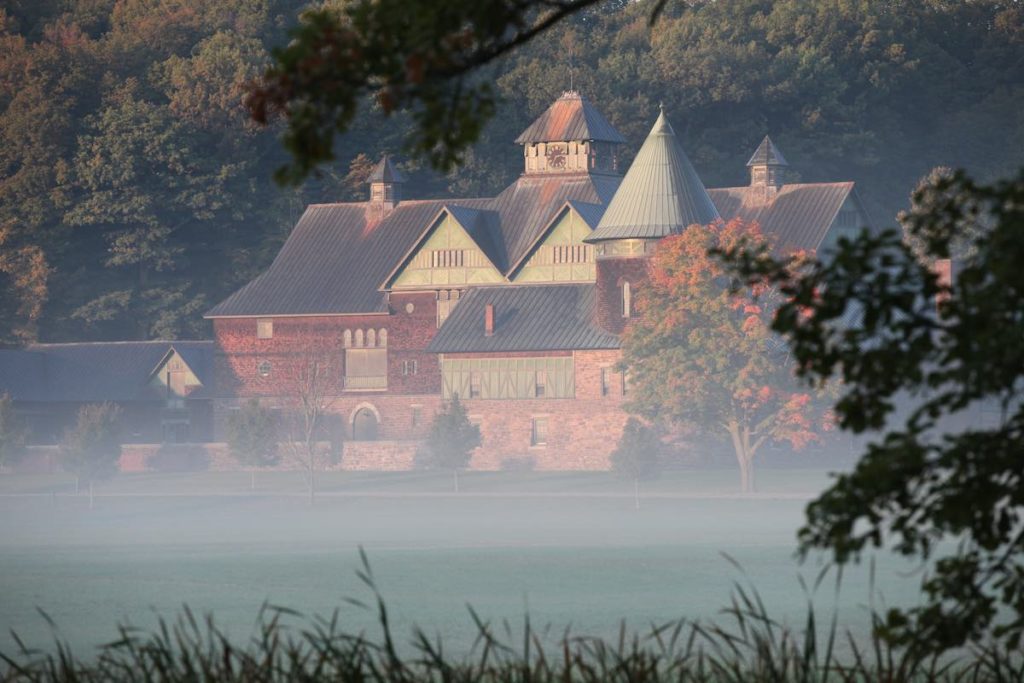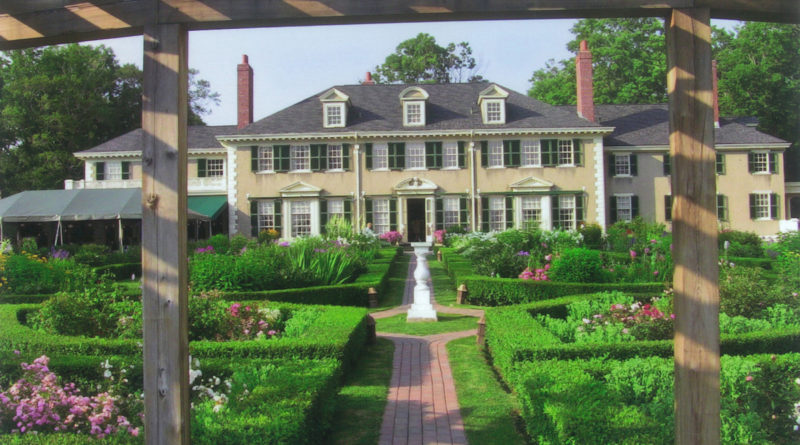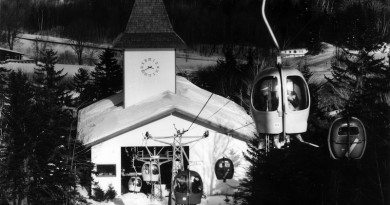7 Ways to Step Back in Time
At these famous farms and grand estates, get a taste of life in Vermont 100 years ago.
Growing up in Vermont, I always felt like there were a million and one things to do on a summer day that were more pressing than piling into the family car to visit a museum. There were swimming holes to explore, blueberries to pick, mountains to hike, and fish to catch. But when we arrived at these historic places, there was always this very compelling feeling of stepping back in time. Even as a kid, I remembered wondering who else ran around that same pasture or thought to climb that big old tree?
Vermont has been home to two presidents, the Lincoln family, and members of the Vanderbilt family. The grand estates these people left behind now give visitors a chance to step back in time and peer into someone’s home, left almost as it was when they lived there – furnishings, artwork, letters and all— creating an intimate, interactive experience.
What’s more, life still goes on at these homes much as it did 150 years ago. Many are working farms that turn out artisan cheeses or homemade breads. On most, there are still miles of paths to walk and farm animals to pet (or sometimes even milk).
At these four historic sites, it’s easy for kids and adults to reimagine themselves in a different era in the Green Mountains.
The Lincoln Family Farm
It’s hard to think of President Abraham Lincoln without imagining him with his stovepipe hat. Only three of those are still in existence and one of them is at Hildene, the estate Lincoln’s son Robert built on the Battenkill outside of Manchester.
Robert was the only one of Lincoln’s sons to survive to adulthood. He became president of the Pullman Company, which was the largest manufacturing company in the world at the time. In 1905, Robert and his wife Mary built Hildene, a 24-room Georgian revival mansion, on a promontory overlooking the Battenkill Valley. His descendants lived there until 1975 and in 1978, the 412-acre property was purchased by a non-profit and restored.
In addition to the furnishings (which include a 1908 Aeolian pipe organ) you can find a 1903 Pullman Sunbeam railway car on the property, which was designed under Robert’s leadership. Take a stroll across the 600-foot floating boardwalk that traverses the farm’s wetland, or hike on one of the estate’s many trails. The 19th century gardens are home to more than 1,000 peonies, and the working goat micro-dairy is the place to watch cheese being made. You can witness everything from milking the herd of Nubian goats to aging Havarti to packaging the fresh Hildene Farm chèvre.
If you’re visiting with kids, be sure to bring them to the butterfly and observation gardens, which were reportedly the favorite play areas of Robert’s grandchildren. hildene.org
Calvin Coolidge’s Homestead
Nestled in the mountains between Ludlow and Killington, the President Calvin Coolidge Homestead and town of Plymouth Notch feel like a time warp. Fifteen buildings make up this preserved village which looks much as it did in the 1800s. Even the powerlines have been buried, and it’s easy to imagine yourself there in 1924 when Calvin Coolidge was sworn in as the 30th president of the United States in the middle of the night at his parents’ farmhouse.

Coolidge loved the hilltop village and nearby trout streams so much he tried to relocate his White House here in the summer, as documented in the exhibit “Presidential Holiday: The Coolidge Summer Retreat,” which runs until October 21.
Apparently, he got so far as to move his staff from Washington, D.C., into Plymouth Notch’s Grange Hall during the summer of 1924. The hall, general store, white clapboard Coolidge family farmhouse and barns are all restored and furnished in the era. You can also visit Coolidge’s gravesite on the property.
In 1890, Calvin’s father, Colonel John Coolidge, along with four other local dairy farmers, built the old Plymouth Cheese Factory. Calvin’s son, John, took over the factory’s operation in 1934. Today the factory is part of the museum. Cheesemaker Jesse Werner found an old recipe taped to the factory walls and derived his cheddar recipe for Plymouth Artisan Cheese from it. You can literally taste history here. coolidgefoundation.org;historicsitesvermont.gov; plymouthartisancheese.com
The Billings’ Farm
If you’ve ever wondered about the nitty gritty details of how people survived in Vermont’s small communities prior to widespread refrigeration, electricity and modern highways, The Billings Farm and Museum’s “Farm Life” exhibits give a glimpse of Vermont daily life a century ago.
Housed in four original barns from the 19th century, the exhibits tell the history of general stores, ice harvesting and maple sugaring. One exhibit details a typical morning in the life of a rural housewife circa 1890.
The farmhouse, built by railroad entrepreneur Frederick Billings in 1890, was considered state-of-the-art in its day and contains a farm office, furnished with period typewriters and clerical tools, a kitchen complete with a wood-fired stove, and beautiful antique furniture. There is also a furnished creamery, which produced 5,000 pounds of butter annually through the early 1900s. A cow from the farm’s Jersey herd was designated the “Champion Heifer of the World” at the 1893 World’s Columbian Exposition in Chicago. The original flock of sheep was imported from the Prince of Wales’ personal herd back in the 1860s and 1870s.
Cows and sheep still graze on the farm’s 248 acres. The house and much of the commercial farm are open to the public with guided tours, children’s farm programs, milking workshops and opportunities to meet the farm animals. On Time Travel Tuesdays, kids can dress up in 19th century clothing and participate in chores using period tools in the old farmhouse. They’ll learn to churn butter, cook a meal on the wood stove, sew and play classic games like tiddlywinks.
The museum also offers pre-packed backpacks that families can check out. The backpacks come with the tools to embark on a kid-oriented, self-guided walk through the property’s gardens and farm facilities.
For the foodie, The Billings Farm provides fresh milk to Grafton Village Cheese, and you can taste and purchase Billings Farm Cheddar at the museum. billingsfarm.org
An Estate for the Vanderbilts
If you want to see how the top 0.001 percent lived at the turn of the century, take a tour at the furnished Shelburne House (now The Inn at Shelburne Farms), built in 1888 by Dr. William Seward Webb and Eliza Vanderbilt Webb. But the best part is the tour ends with tea in the estate’s terraced gardens on the shore of Lake Champlain. If you want to spend more time there, take a dip in the lake which laps up on the pebble beaches, book dinner at the stately dining room or consider checking into one of the 24 rooms and four cottages, each furnished with period antiques from the family’s collection.

The Inn is the jewel of the 1,400-acre Shelburne Farms, designed by Frederick Law Olmstead (the landscape architect behind New York City’s Central Park). The property includes several vast barns, including the Coach Barn, the Dairy Barn, the Breeding Barn, and the Farm Barn, which at the time they were built were among the largest Tudor-style barns ever constructed. Eliza was a member of the Vanderbilt family, then one of the wealthiest families in America. Her $10 million inheritance helped create the estate which her descendants, the Webb family, turned into a non-profit focused on agriculture education and sustainable farming.
At the Farm Barn, just a short walk or drive away from the main house, you can watch Shelburne Farms’ award-winning cheddar being made (sample the Tractor Cheddar for a sharp taste of old Vermont) and learn to milk a Brown Swiss cow. Don’t miss the chicken parade at the Children’s Farmyard and be sure to buy a loaf of sourdough spelt artisan bread or a ginger molasses cookie from O Bread Bakery, which the Conway family has been operating in one wing of the Farm Barn since 1977. If you’re looking to take a hike, plan a picnic on top of Lone Tree Hill with its stunning view of New York’s Adirondack Mountains across Lake Champlain.
At the nearby Shelburne Museum, view Impressionist paintings, dollhouses, antique firearms, and quilts from the 19th and 20th centuries and rare hatboxes collected by Eliza and William’s daughter, Electra Havemeyer Webb. The collections are housed in 39 barns, houses, blacksmith shops, and other buildings. Be sure to explore the inner cabins of the steamboat Ticonderoga, which was hauled nearly two miles to the museum from Lake Champlain in 1955. If they are good, take the kids to tour the relocated Colchester Reef lighthouse, and if they are bad, to the Castleton Jail. After, head across the street for penny candy or a maple creemee at the Shelburne Country Store. shelburnefarms.org and shelburnemuseum.org
3 More Slices of Life
For a different take on local life, these three museums are little gems. Ferrisburgh’s Rokeby Museum is a restored Quaker homestead and perhaps the best-preserved Underground Railroad site in the country. The museum’s ongoing exhibit “Free and Safe: The Underground Railroad in Vermont” documents the stories of Simon and Jesse, two fugitive slaves who took shelter at Rokeby in the 1830s. The museum is an homage to Vermont’s role in the Underground Railroad and you can take a walk to the ruins of the Brick Academy, founded by Rowland Robinson in 1839 prior to public high schools, where students studied extreme pacifism. Rokeby.org
Since 1884, Middlebury has operated the oldest community-based museum in the country, The Henry Sheldon Museum. This summer, poignant black and white photos from the 19th and early 20th centuries document life this central Vermont village: baseball games, family portraits and school photos from Addison County adorn the walls of the 1829 Judd-Harris House for the exhibit “Our Town: Love, Joy, Sadness and Baseball.” The photos were restored and enlarged by Middlebury resident and retired National Geographic photographer James Pease Blair. henrysheldonmuseum.org
It’s not every day that you see a Gothic Revival farmhouse in Vermont, but at the Justin Morrill Homestead, the dramatic architecture and gardens filled with serpentine walkways, magnolia, roses, and herbs transport visitors to a different time. The home was built in 1851 and is located in Strafford. After leaving high school at age 15, Morrill went on to become a Congressman, representing Vermont in the House and Senate for a combined 44 years
He is credited with the Land-Grant Act, which provided federal funding for schools that taught agriculture, business, engineering, and economics. When you’re done, stop by nearby Strafford Organic Creamery for decadent, farm-fresh ice cream. morrillhomestead.org or straffordcreamery.com.



